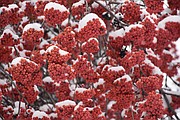Mountain ash: Brightening winter in Boundary County!
Don Bartling Contributing Writer | Hagadone News Network | UPDATED 6 years, 11 months AGO
Driving around many neighborhoods in Boundary County through the fall and winter, you’ll find yourself brushing past clusters of showy orange berries, hanging down from the limbs of mountain ash trees. By late winter many of the berries have fallen to the ground, but through much of the drab months they provide a warm spot of color against the gray sky and white snow.
The mountain ash is a popular decorative tree, especially amongst wildlife watchers who use its fruits to attract wintering birds. Its moderate height means that the mountain ash isn’t too much of a problem for power lines, and it is tolerant of conditions like strong winds and clay soils.
As one of the few trees that maintains its berries through the winter, the mountain ash can be an important source of nutrition for non-migratory bird species. If a human were to pull down some mountain ash berries and take a mouthful, however, the unlucky forager would probably spit them out immediately. Regardless of their appetizing appearance, the berries are bitter and rich in sorbic acid, only tolerable to humans after being cooked at high temperatures for jellies or jams. Despite that challenge, they were once taken aboard long sea voyages in those processed forms as a means of preventing scurvy, since they are rich in both vitamins A and C.
The birds don’t mind the bitter taste, of course, and are quite content to eat the berries just as they are, although there are reports that hard frosts can cause the berries to ferment, leading to sightings of tipsy birds as their food source suddenly becomes inebriating.
The species indigenous to this region is Sorbus Americana, known colloquially as American mountain ash. This small to medium tree (up to 50 feet tall) has light grayish bark and an oval, open head at maturity. It produces clusters of white flowers in spring followed by bright, long-lasting, orange-red berries (called pomes) in fall that attract birds.
The deciduous leaves are toothed and pinnately compound. They are dark, dull green in summer and yellow to reddish in fall. Because of their nutrition and persistence, the pomes provide an important food source for a variety of winter bird species.
Although bohemian waxwings are the birds most often seen gobbling mountain-ash berries in the winter, many other species will also dine on them. Grosbeaks and house finches feast on the berries, and a quick reference search indicates that many other species will as well: cedar waxwings, ruffed grouse, starling, robin and northern flicker. The seeds are indigestible, so birds are responsible for “planting” mountain-ash trees far and wide.
I always look forward to driving around Boundary County and seeing the mountain ash in winter. The mountain ash trees brighten yards and feed birds with their colorful berries in our cold, gray days; they just seem to brighten up the winter in their subtle way.
Enjoy Boundary County and all its beauty.
ARTICLES BY DON BARTLING CONTRIBUTING WRITER

About the Douglas fir
“The big tree is nature’s forest masterpiece, and so far as I know, the greatest of living things.” — John Muir 1838-1914 “Father of the National Parks” and author.

Winter on the hoof: How deer, elk and moose cope with the snow!
“When snow falls, nature listens.”




